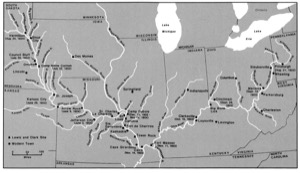August 30, 1803
[Lewis]
Left Pittsburgh [2] this day at 11 ock with a party of 11 hands 7 of which are soldiers, a pilot and three young men on trial they having proposed to go with me throughout the voyage. [3] Arrived at Bruno's Island [4] 3 miles below halted a few minutes. went on shore and being invited on by some of the gentlemen present to try my airgun [5] which I had purchased brought it on shore charged it and fired myself seven times fifty five yards with pretty good success; after which a Mr. Blaze Cenas [6] being unacquainted with the management of the gun suffered her to discharge herself accedentaly the ball passed through the hat of a woman about 40 yards distanc cuting her temple about the fourth of the diameter of the ball; shee fell instantly and the blood gusing from her temple we were all in the greatest consternation supposed she was dead by [but] in a minute she revived to our enespressable satisfaction, and by examination we found the wound by no means mortal or even dangerous; called the hands aboard and proceeded to a ripple of McKee's rock * [7] where we were obleged to get out all hands and lift the boat [8] over about thirty yards; the river is extreemly low; said to be more so than it has been known for four years; about [blank] we passed another ripple near [erasure] Past another bear or ripple with more dificulty than either of the others halted for the night much fatiegued after labouring with my men all day— [9] the water being sufficiently temperate was much in our favor; gave my men some whiskey and retired to rest at 8 OClock—
*a discription of this place to [follow?]



